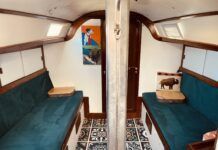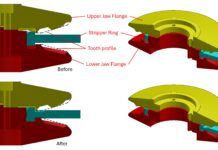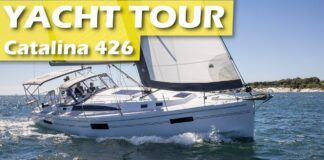
I just received the June issue and was pleased to see the sandbaggers Bull and Bear on the cover. However, when I looked inside for the cover photo description, I saw one, possibly two errors. The description reads: The replica 1860 Sandbaggers, Bull and Bear, offer students in Maine a real-world exercise in sailboat stability.
First: Bull and Bear have not been in Maine for over 10 years, and then they were only there for a short while. For the last five or six years, they have been used in Annapolis, Md., by the National Sailing Hall of Fame to provide lessons in science, technology, engineering, and math to highschool students.
Second: If I am not mistaken, the photo was taken in Annapolis. I have skippered the sandbaggers for several years now, and Im pretty sure the dock in the photos background is the Eastport Yacht Club in Annapolis.
Still, thank you for featuring these amazing boats on your cover.
Dan Walker
National Sailing Hall of Fame
www.nationalsailinghalloffame.org
The page 2 caption for the cover photo in the June 2015 issue gave the incorrect location for the photo. It should have identified the locale as Annapolis.
Since bottom paint formulations seem to change every year, I wait for the latest bottom paint report before I put my boat in the water. This year, I was dismayed to see that all 55 paints tested did no better than a poor rating (see PS April 2015 online). The data indicates that its futile to expect that long a period of protection.
As a reader noted in his letter in the April 2015 Mailport, every boater {in his area} hauls and repaints every year. Why not focus on 12-month performance and keep a handful of the best for an extra six months testing. I would go further, in Great Kills Harbor, N.Y., and other high-fouling harbors, a paint rating at six months would be even more useful. And it would probably be easier on the testers, too.
Regional reports should be re-established as well. The bugs in the North East are different from those in your Sarasota, Fla., test site.
Simon Zorovich
PoleStar, Beneteau First 44.7
Great Kills, N.Y.
We would not say that it is futile to expect long-term protection. Remember that because we do not move or clean our test panels, the paints will almost always do better in real-world use on a boat that is used. (An exception may be the workboat ablatives, which are true sloughing paints.) For example, two of the paints that failed at 18 months on our test panels are still barnacle free after three years on a test boat that was cruised between the Chesapeake and Bahamas and had its hull routinely cleaned every 30 to 60 days.
Also, many paint formulas don’t change at all. Interlux keeps most of its formulas the same from year to year. The same is true for the core Pettit paints-Trinidad, Horizons, Vivid, etc. With the exception of Blue Water paints, which seem to be reformulated regularly, most of the paints seeing formula changes are the eco-friendly, low-VOC variety. This years batch saw more changes than average due to the fact that the biocide booster Irgarol is no longer available in the U.S. (see Rhumb Lines, PS April 2015).
Our semi-annual reports, which appear in the October and March or April issues, offer ratings on the test panels at various stages, including six, 12, 18, and 24 months. A quick search of our online archive should give you a list of the most recent bottom paint reports with the six- and 12-month results.
Bugs (soft growth) are different, but the biocides operate the same way. (Vermont is full of Subarus, Alabama not so much, but the cars work the same in both locales.) Sometimes, the regional preferences are driven by marketing.
Well look into restarting a New England test, but as we recall, there was more often than not a direct correlation between the two locations when it came to top picks. Paint makers who have multiple test sets across the country tell us as much. We do still have test boats in several locations in New England and on the West Coast.
Check out our March 2014 report on favorite bottom paints by region. If youre looking for single-season protection in the Northeast, consider Pettit Ultima SSA, Interlux Fiberglass Bottomkote ACT, or West Marine PCA Gold (made by Pettit).
In regard to the May 2015 article on rig failures: Large sailboats are required to unstep and thoroughly inspect their rigs every five years to maintain classifications-same with physical inspections of all chainplates. There is no way to adequately inspect a rig without unstepping. And if they are painted, owners must remove the paint to look for corrosion and stress cracks.
Standard practice in the Caribbean is to replace swage fittings every five years. Best practice is using Sta-Loks with a careful yearly inspection of the wire. Boats stored with rigs in place on the hard may induce more stress than realized. Replacing rigging at least every five years is cheap insurance when sailing blue water-as are carrying out inspections for life rafts.
Be mindful that rod rigging is not exempt from to required periodic replacement. Losing a rig offshore for whatever reason can be a real bad day. When replacing stays, its a fools errand not to also replace halyards, sheets, and worn blocks and shackles. Charter boats need special attention as their rigs are often not designed for extended blue-water service.
At the days end, replacing rigging periodically is like repacking the life raft as required. Its just good, old-fashioned seamanship, and it might just save your life.
Peter I. Berman
Author, Outfitting the Offshore Cruising Sailboat
Norwalk, Conn.
Ive been a sailor most of my life but now own a Cape Dory 33 power yacht. The house bank is four Deka 8A31DTMs and one engine-start odyssey 4D. They are separate banks, so the way they are used doesn’t fall into the exact situations described in the May 2015 article on fighting sulfation in AGMs. When the boat is moving, the engines are running, so engine charge time is way up. At the dock, I don’t like leaving my Freedom Hart 2500 inverter-charger running unless for some reason I have drawn the batteries down. But even then, I will run the charger only for a day or two. Normally, after a days run of six to eight hours, I am assuming the batteries are fully charged, judging by the volt meter on my electrical panel.
You start to talk about equalizing batteries and mention that even the manufacturers don’t give details about this. Is it your opinion that you should never do this, or are you saying or implying that equalizing should only be done at your own risk? Might equalizing help the sulfation issue with AGMs?
Al Halpern
Hunky Dory, Cape Dory 33
St. Pete Beach, Fla.
The short answer: Dont try it. The only AGM that specifies an equalizing routine (charging well above normal voltage after absorption phase) is the Lifeline battery we reviewed, and you need to be careful not to overcharge. AGMs and gel-cells are not meant to be charged at this voltage. We would strongly caution against doing it, as you can permanently harm the battery. It is different for wet-cell batteries, which can be equalized.
A question in regard to your May 26, 2015 blog post, Decontaminating a Tainted Water Tank: Can we reduce the chlorine concentration and increase the time its in the tank? What level of chlorine concentration is safe to discharge into the water?
Michael Moorman
Rock Hall, Md.
Via Inside Practical Sailor
The bleach concentration given was for four-hour contact time, with an option of increasing the concentration for a shorter time. The American National Standards Institute (ANSI) does not recognize lower concentrations. This amount of bleach will be very quickly oxidized to chloride and should pose no hazard to the environment. If you would like to neutralize the bleach before discharge, add an equal amount of hydrogen peroxide (3 percent), mix, and allow it to react for one hour. This will oxidize the bleach to chloride, as described in the article.

I enjoyed the soft-shackle article (see PS April 2015 online) and went ahead and made several soft shackles. However, using them with eye-spliced sheets has caused chafing on the eye splice. Is this a common problem? Do you have suggestions for a solution?
Phil Haydon
Via www.practical-sailor.com
We have not had any eye-splice chafing problems with the soft shackles, nor have other readers reported any to us. We would think the Amsteel shackles are too slippery to chafe anything. Assuming your sheets are polyester, we would suggest using Yale Cordages MaxiJacket penetrating rope coating on the wearing portions of the eye. (See chafe protection article, PS March 2015 online.)
In response to your wiring terminal article in the February 2015 issue: Adding dielectric bulb grease to every connection works wonders. I fill the female of every connection, including the crimp that the wire is inserted into. A dab over the set screw stops corrosion. Fill the backs of all the connectors on the engine, too. One tube bought at AutoZone for about $6 appears to be a lifetime supply.
After reading your article, I am going to add the ferrule connectors to my electrical kit. I didnt know they existed.
Barry Needalman
Via www.practical-sailor.com

I just purchased a Standard Horizon HX870 handheld VHF (see PS April 2015 online) to meet the safety requirements (DSC capability) for the Singlehanded Farallones race out of San Francisco Bay. You can imagine my shock when, 20 miles offshore and nine hours into the race, I heard a loud beeping from the radio indicating my battery was almost dead.
It was fully charged just before the race. I transmitted for about 30 seconds total to check in to the race and was scanning four channels: 16, 12, 14, and 66. There was some receive traffic but only about 10 minutes total. For receive only, nine hours seems low.
Also, I wear the radio on my PFD-harness and am not staring at the battery bar. Given the safety element this radio offers, I would like earlier warning-say one hour away from dead or some such.
I spoke with Jason Kennedy, an executive vice president at Standard Horizon, about the battery problem, and he gave me a very thorough run down on how to configure the unit to minimize power drain, including power save on the GPS and backlight, and turning off the GPS logger. I will give all of these a shot, and I suspect, they will improve things substantially.
I was impressed with Kennedys willingness to spend some time with a customer. Guys like this make or break a consumer electronics company. I would like to make sure Standard Horizon is recognized for its customer service.
Mike Cunningham
Jacqueline, 1986 Freedom 30
San Francisco Bay Singlehanded
Sailors Society
Discovery Bay, Calif.
In our review, the Best Choice HX870 lasted nine hours in the battery life test; the maker claims it has up to 12 hours of run time on a single charge, depending on settings. So our experience was similar to yours. Unlike with the Recommended Icom M92D and Budget Buy Standard Horizon HX851, theres no way to recharge the HX870s 1,800-mAh, lithium-ion battery when the VHF is not in the charging cradle. We suggest keeping handy a spare, charged battery pack, as well as the supplied alkaline-battery tray and plenty of extra AAAs; rechargeable alkalines will work in the tray, but rechargeable lithium-ion AAAs are not recommended because transmission voltage could be affected.
Standard Horizon offered some tips for maximizing battery life in the HX870. Users should make sure that the GPS logger feature is turned off. If the GPS logger function is activated, the GPS Power Save feature is disabled. Also the company recommends turning the backlight lamp off when it is not required; the continuous backlight setting will deplete the battery quickly. One of the more handy features of the HX870 is its battery saver mode, which puts the radio to sleep for a user-selected time interval, periodically waking it up to check for activity. If somebody is talking on a channel, the HX870 will remain in the awake mode, then resume its sleep cycles.

Regarding the review of womens foul-weather gear in the March 2015 issue: First, huge kudos to Gill. I purchased their OS2-equivalent jacket and pants in 1999. Sailing on Lake Superior, even on a lovely summer day, means they received pretty heavy use. After 13 years, the jacket fabric suddenly puckered and started leaking. Gill stood true to its lifetime guarantee and promptly replaced it with the new OS2 jacket.
This was especially nice for me, because now they have womens sizing. But I am extremely disappointed with the color options.
Gill still makes mens gear in high-visibility yellow, but not womens gear. This implies that women care more about wearing a fashionable color, than being found floating in dark, cold, life-threatening waters. Having extensive experience finding very small objects floating in very vast oceans, as well as now sailing in waters that average 50 degrees, I choose the quickest recovery possible, which includes wearing high-visibility colors. Besides, I happen to like the fashion statement traditional yellow foul-weather gear makes.
Kathy Tokos
Seiche, Ericson 34
Bayfield, Wisc.
Weve gotten several letters from readers expressing the same frustration, and we couldnt agree more. Bright orange or yellow are good choices for foul-weather gear, but studies have
In the May 2015 article Hidden Cause of Rig Failure, we gave incorrect credit information for photos numbered 7 to 11 on pages 24 and 25. Those photos were supplied by John Koon, a highly regarded, certified marine surveyor, based in Honolulu, Hawaii. Koon also supplied much of the background information for that article.
In the June 2015 issue, callouts were omitted from illustrations on page 27 and 28. These have been corrected in the online edition.





































